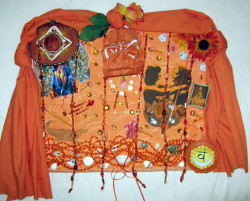Last week, I began to investigate the complex and enlightening world of the chakras as mapped out by Anodea Judith in her book, Eastern Body, Western Mind. Many days have passed since I discovered my roots in chakra one, and this realigning of how I walk, sit, stand, and understand my physical body in the world has already had a profound effect. I’m ready to move upward along my internal rainbow bridge of energy, to chakras two and three.
Chakra Two: Svadhisthana
If, like me, you were just getting comfortable in feeling the ground support you, everything is about to change with chakra two, located in the lower abs and sacral plexus. Exemplifying the principle of duality between these first two energy centers, svadhisthana is apposite to grounding: It focuses on movement and flow, symbolized by water and the color orange. Judith explains that a firm understanding of the earth—chakra one—provides a supportive and ample container for the watery energy of chakra two. Problems arise when there is disequilibrium between the two: not enough earth or too much or too little water to have a healthy ecosystem within ourselves.
Chakra two brings to our awareness the right to feel, particularly the right to feel pleasure. It connects us to our spiritual, physical, and sexual identities—enabling us to be joyful, playful, and intimate with others on all levels. When we have and accept pleasure in our lives, we are equipped with the tools to grow up from our roots in the earth and act and thrive as individuals, sending energy ever upward toward enlightenment.
Developing between the ages of six months and two years, a healthy second chakra very much depends on how well we were able to separate from our parents as children. At this age we gain physical mobility and are able to engage in the world with increasing awareness and attention. We understand what feels good and what feels bad, and we’re very attuned to the touch of our mothers in particular. When we separate too much or too little from these modes of sensation–not enough hugging, or an overabundance of hedonistic stimuli–we may have problems establishing our own emotional identities. If we are subject to insufficient physical contact, have our feelings subsumed to those of our parents (called enmeshment), or are exposed to any sort of sexual or physical abuse, the second chakra will be deeply affected. Trusting our own feelings and sense of boundaries becomes impossible, and it’s easy to give in to the demon of the second chakra, guilt. We deny ourselves pleasure, and these repressed parts of ourselves can eventually be forgotten, leaving entire components of our identities stunted and unevolved.
 When a person has a deficient second chakra, guilt is in complete control. One’s boundaries are very strong and thus sexuality and socializing are limited. Introverted and resistant to pleasure, these individuals hold their bodies rigidly but may appear to be pulling themselves inward in their lower halfs as all of that blocked energy channels up to higher chakras.
When a person has a deficient second chakra, guilt is in complete control. One’s boundaries are very strong and thus sexuality and socializing are limited. Introverted and resistant to pleasure, these individuals hold their bodies rigidly but may appear to be pulling themselves inward in their lower halfs as all of that blocked energy channels up to higher chakras.
Conversely, an excessive second chakra will manifest itself with intense emotions and a desperate need to socialize. Unable to distinguish emotional and physical boundaries, one might become highly responsive to others’ emotions to the degree of clairsentience—a kind of extreme form of empathy. Excessive second chakras are very codependent and rely on others to soak up their overflowing stores of water. For both excessives and deficients, addiction is a common response as a means to create or deny the feelings that are blocked within ourselves.
The key to allowing these waters to flow evenly and effectively is establishing connection with sensations and meeting basic needs. As is true of the planet earth itself, there is a natural internal process that helps to manage the dynamic nature of feelings—it’s only when we thwart or challenge that process that we become stuck, immobile, frozen. Western society provides its own obstacles to having an open second chakra. Our culture tends to de-emphasize the importance of feelings and sexuality, creating taboos and rules that set limits on how, when, what, and with whom we can feel. Looking behind these social norms—and finding the reasonable, innate system within—can lead to a much happier life and better interpersonal connections at work and at home.
Because it is located in the low belly and hips—think the origins of life—hip and groin openers in yoga class will help alleviate blocked second chakras. Cow pose, pigeon pose, and bound-angle pose are just a few examples; you may have heard stories about people spontaneously weeping in pigeon pose, and now you know why. But essentially, whatever movements make you happy will ignite the chakra of sweetness in you.
Chakra Three: Manipura
Emerging from the pools of svadhisthana, we’re met with a welcome antidote in chakra three: manipura, or the chakra of power, located in the solar plexus (the navel). Represented by fire, this is the place where our sense of grounding and pleasure—need and desire—are transformed into action. Think of the process this way: if you’re hungry and like chocolate, you’ll get up to go find a piece to eat. Or, if you’re cold and know that a cozy knit sweater will feel good against your skin, you’ll put it on. When the third chakra is flowing well, we can use will power to expand our sense of individuality, to act in ways that combine with others’ power synergistically. In this sense, the material experiences of our lower chakras flow up to the consciousness found in the upper chakras; we as individual bodies merge into a more collective state of universality.
Between 18 months and 4 years is when manipura begins to blaze in its yellow glory: hence the terrible twos. This is the time when we’re first able to communicate and assert ourselves as individuals, and also to control bodily impulses via toilet training. How we relate to the authority figures during these influential years greatly impacts the vitality of the ego forming at this time. If the adults in our lives elicit fear, then we are rendered powerless: we can act out of compliance, withdrawal, rebelliousness, or manipulation. Likewise, if authority figures expect too much of us as children (parentification), then we’re doomed to feel inadequate in our inability to exert the power that’s demanded. The demon of shame will set in once our actions are cast in such a negative light. Our internal mantras become “you should be ashamed for doing or saying such-and-such,” and our identities are bound by shame. Instincts retreat before an assault of thoughts and judgments.
 While our culture encourages personal power, it is not always to achieve the same balanced ends (or means) as in the chakra system. Indeed, when individuals are highly accomplished and motivated—i.e., in positions of power per social definitions—they often have low self-esteem because they’re driven not by desire or need but by external markers of success: what we should or should not do and value. Moreover, child-rearing practices encourage “breaking the wills” of children so that they are well behaved and obedient. This of course has its benefits, but without individual will society itself—in the collective sense—cannot thrive.
While our culture encourages personal power, it is not always to achieve the same balanced ends (or means) as in the chakra system. Indeed, when individuals are highly accomplished and motivated—i.e., in positions of power per social definitions—they often have low self-esteem because they’re driven not by desire or need but by external markers of success: what we should or should not do and value. Moreover, child-rearing practices encourage “breaking the wills” of children so that they are well behaved and obedient. This of course has its benefits, but without individual will society itself—in the collective sense—cannot thrive.
When the third chakra is excessive, all actions are motivated by power and control but without a great sense of their intrinsic purpose. Always looking for something to do, these people maintain rigid, ceaseless routines and grow uneasy in the face of idleness. They can appear on the outside to have great will power, often perfecting their bodies as athletes but pushing themselves to extremes in so doing. They move their bodies well but their souls are left sitting on the sidelines, unable to participate out of fear that joyful energy will result in disapproval.
Fear of shame also causes deficiencies in the third chakra but in the opposite way: There is a complete lack of discipline and energy, and one cannot take responsibility for one’s actions. Instead, deficients will feel victimized—that things are done to them, rather than by them. And whereas excessive third chakras are overly rigid and upright, deficients may exhibit a collapsed torso due to the lack of support in the solar plexus, whereby breathing and vision—our engagement with reality and home to upper chakras—become distorted and blocked. Poses like mountain pose or bow pose can help assert the presence of the abdomen, and feel its strength and support.
For both excessive and deficient types, restoring a lasting internal flame requires giving up what we feel and know is safe, breaking boundaries and taking risks as individuals. We must instead ignore external demands of our energy and find ways to fuel ourselves to accomplish things that are personally satisfying. This is as basic as eating right and exercising to initiate heat, but also simply doing nothing when there is too much rigidly exerted energy. I blame the third chakra, then, for my tardiness in writing this post as I put down my (comforting) list of things I should do and traded it for the list of what I could do. My lustrous gem was dusted off and able to burn more brightly and cleanly as a result.
These two chakras are also inextricable from a yoga basic: the breath. Whenever we inhale and exhale, the belly moves, too, reminding us of the natural balance within our bodies. Refreshing oxygen enters these regions of movement and action. Last night in class, I found that my breathing—acknowledging the sensation of the air moving in my body, and how it helped me sustain more difficult poses but also move between poses—was much more restorative and meaningful. This puts me in an ideal position to explore next week’s chakra: air, the site of balance and love.
Next: The Chakra System and You – Part III
Don’t miss: The Chakra System and You – Part I
Also by Jennifer: How to Set Goals for a Happy Life
___
Photo: Laura Heller via Flickr




